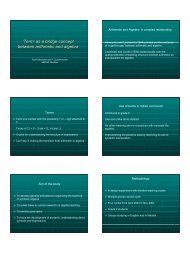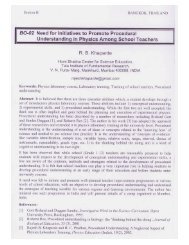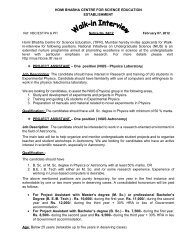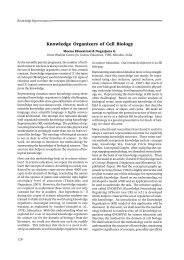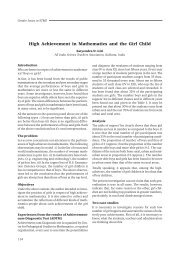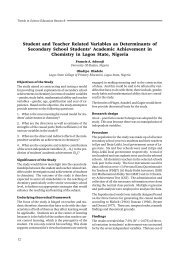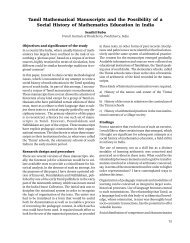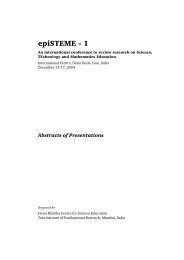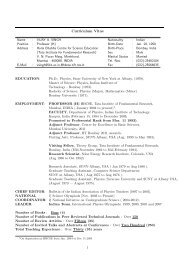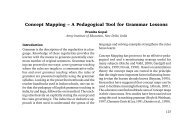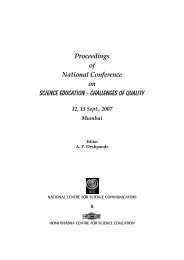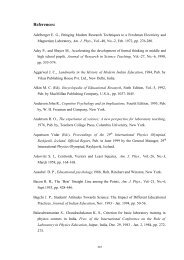Review presentation epiSTEME - Homi Bhabha Centre For Science ...
Review presentation epiSTEME - Homi Bhabha Centre For Science ...
Review presentation epiSTEME - Homi Bhabha Centre For Science ...
You also want an ePaper? Increase the reach of your titles
YUMPU automatically turns print PDFs into web optimized ePapers that Google loves.
Visual-Spatial Modes in<strong>Science</strong> Learning<strong>Review</strong> talk at <strong>epiSTEME</strong>-2HBCSE, TIFR, Mumbai, February 2007Jayashree Ramadas<strong>Homi</strong> <strong>Bhabha</strong> <strong>Centre</strong> for <strong>Science</strong> Education (HBCSE)Tata Institute of Fundamental Research, Mumbai
The series:Why this review?An integrated conception of <strong>Science</strong>, Technologyand Mathematics EducationUniting themes in:• Cognition• Pedagogy• History• Philosophy• Social and Cultural context
…Why this review?Visual-spatial modes in science learning• A largely unexplored area• Inadequacy of purely propositional models• Research interest at HBCSE– Visual-spatial thinking in science, technology andmathematics education– Three faculty, five courses in 5 semesters, three Ph.D.projects– <strong>Science</strong> education: learning, curriculum
<strong>Review</strong> and Overview• Visual-spatial aspects of doing and learning science• Integration of visual-spatial with verbal and other modes(creativity, memory, communication and collaboration)• Multi-modal nature of cognition• Model-based transformational reasoning- evidence in science- cognitive analyses- through drawings- by experts- in learning of science• Two ongoing research programs: in biology and in physics
Doing science1. Conception of great ideas"... The psychical entities which seem to serve as elements in thoughtare certain signs and more or less clear images which can be'voluntarily' reproduced and combined ... The above mentionedelements are, in my case, of visual and some of muscular type.Conventional words or other signs have to be sought for laboriouslyonly in a secondary stage ... ... the play with the ... elements isaimed to be analogous to certain logical connections one issearching for. ... In a stage when words intervene at all, they are, inmy case, purely auditive, but they interfere only in a secondarystage ..."A. Einstein, quoted in J. Hadamard, 1949• Introspective reports of mental imagery; historicaldocumentation(J. Hadamard, E. Ferguson, G. Holton, R. Shepard, A. Miller, C. Kierns)
…Doing science2. Everyday practice of experimenters andtheoreticians
…Doing science3. Communication and argumentation in science- visual depictions- verbal communication of visual experiencesLearning science- Memorable diagrams
…Learning science- Visual descriptions in pedagogyAtomism is by no means self-evident. If we can trust oursenses, most types of matter seem "all one piece". A sheetof paper or a drop of water does not seem to be composedof particles.This, however, is not conclusive. The sand making up abeach, if viewed from a distance, seems all one piece. It isonly upon a close view that we can make out the smallgrains of which the sand actually consists. Perhaps, then,paper or water is made up of particles to small to see....If a cloud chamber is placed between the poles of a magnet,charged particles travel in curved paths, and the waterdroplets indicate that. From the direction of the curve, onecan determine whether the charge is negative or positive;and from the sharpness of the curve, one can makedeductions as to the e/m ratio.(I. Asimov, Understanding Physics, 1966)
Psychological researchon visual modes of thinking• Early introspective methodsFrancis Galton's studies of imagery
…Psychological researchon visual modes of thinking• Recent experimental approaches– chronometric studies– memory studies– spatial reasoning• Documentation of practice– visual communication of ideas in science– and in learning– visual tools mediating cognition– collaborative learning
…Psychological researchon visual modes of thinking“a spontaneous kinetic image ofthree dimensional structuresmajestically turning in space”– R. ShepardHow do we conceptualize moleculesin stereochemistry?Shepard and Metzler (1971). Mental rotation tasks
Creativity and discovery in the laboratory• Mental processes are linked with perceptualprocesses BUT• Mental "images" have both depictive and descriptivequalities• Mental images carry abstract elements tooApparently simple and de-contextualised mentalimages carry meaning that is not entirely capturedby their visual and spatial properties
Creativity and discovery in the laboratoryCreativity and discovery is helped by• Mental manipulation / transformation of images• Transforming information between verbal andimaginal. Interference between imagery andlanguage is also possible.• Doodling, drawing, seeing and hearing,gesturingConclusions• Multi-modal nature of cognition• hence, mental models• "Transformational" reasoning with models
Multi-modal nature of cognition• Synesthesiae.g.– Numbers as colours– Cross-wiring between adjacent areas in thefusiform gyrus (V. S. Ramachandran)BoubaKiki
Cognition is inherently perceptual• Abstract concepts are derived from complexconfigurations,• of multimodal perceptual information,• distributed over time (Barsalou, 2003)• Visual, kinetic and auditory images(Hadamard, 1949)
From mental images to mental models• Not a picture in the mind• But a scheme for depicting and processing visual,spatial (and other) information• Other = broadly conceptual
Cognitive – historical studies ofvisual thinking in science• Knowledge-rich domains• Long-term commitment to model(in contrast to milliseconds to minutes)• Social context of science- Styles and tools of discourse(Nersessian, 1995; Giere, 1996; Kierns, 1999)
Transformational reasoning in scienceexample: Early biologyVisual images recorded as drawings• Depictions of individual specimens transformedinto idealised re<strong>presentation</strong>s of types, ideals orspecies• Generalisations drawn from visual imagescodified and elaborated into taxonomy• Comparative anatomy (G. Cuvier (1769-1832))• Transformations of biological forms (D'ArcyThompson, 1917)• Structure (static) - Function (dynamic)
From Ronan, Colin A (1983). The Cambridge IllustratedHistory of the World’s <strong>Science</strong>. Cambridge: CambridgeUniversity Press.Leonardo da Vinci, (1452-1519) Renaissancemaster made detailed drawings of the anatomy andphysiology of the horseDiagram of a horsehttp://www.ansi.okstate.edu/resourceroom/general/horse/horse.htm
Transformational reasoning in scienceExample: Electromagnetic theoryFaraday's lines of forceMutually embracing curves
Cognitive analyses of transformationalreasoningEarly childhood:"reproductive imagery“Late childhood:"transformational reasoning“But large individual differencesin the adult populationPiaget, 1971
… Cognitive analyses oftransformational reasoning• Psychometric data(Hegarty and Waller, 2005)Two cognitive processes:1. Construction of an image (limited by time)2. Its transformation in memory (limited bycomplexity)- Object-centered- Viewer-centeredTransformational ability is correlated with successin mechanical occupations, mathematics, physicsand medical professions (Hegarty and Waller, 2005;Tversky, 2005).
Transformational reasoningthrough drawings• Two functions of children's drawings: expressive anddepictive• Two ideas about depictive drawings:1. Transition from what we know to what we seeSchematic stage to visual realism.Wales, 1990
Transformational reasoningthrough drawings2. Procedural view - conceptualschemata constructed throughactivity, reflection and theinfluence of culture(Olson, 1970)Problem-solving - task-specificconventions, strategies andorganising principles(Freeman, 1975; Goodnow, 1977)
Transformational reasoningthrough diagramsDiagrams exploit properties of the visual system- detecting spatial and geometrical relations- efficiently encoding such information- going beyond it to form generalisations(Larkin and Simon, 1987; Pylyshyn, 2003)A diagrammatic re<strong>presentation</strong>of a pulley problem as describedin:‘Why a diagram is (sometimes)worth ten thousand words”Larkin and Simon (1987).Cognitive <strong>Science</strong> 11, 65-99.
Transformational reasoningthrough diagrams• Diagrams use space to convey abstract concepts– External referential meaning (complex reality)– Internal meaning (inscription)– Rules for transformation are simplified– A series of abductive leaps– Warrant for beliefSimon, 1996• In technology education: exploratory sketchesprocedural map construction
Studies of visual thinkingin the learning of scienceEarly studies are motivated by computer visualisations forpedagogy (Gilbert, Ed., 2006)Need to take account of:• <strong>Science</strong> and its pedagogy• Developmental factors• Social context of learning- Styles and tools of discourseThe issues:• Conception, re<strong>presentation</strong>, transformation, communication• Model-based transformational reasoning, manifested inways characteristic of the domain
Some observations• Visual-spatial images are easily susceptible totransformations: in the mind, or externally viaconcrete models, or on paper.• Images can hold powerful metaphoricalconnotations which suggest relations andconcepts extending beyond their concretephysical form (Arnheim, 1969; Tversky, 2005)• Mental manipulations and transformations ofimages are a recurrent theme in the history ofscience (Shepard, 1978, 1988; Miller, 1984; Nersessian, 1995;Topper, 1996)
Transformational reasoningin science / learningactivityPhysical world Mental worldsocial contextObservationPredictionDescriptionExplanationReal situationSchematisation(Model-based)visual re<strong>presentation</strong>Model-based visual re<strong>presentation</strong>RestructuringExternal re<strong>presentation</strong>
Drawings in the learning of scienceSome prerequisites• Familiarity with the medium• Picture-text linkages• Unit of comprehension• Cultural priorities
Drawings in the learning of scienceSome prerequisites
Transformational reasoningin the learning of scienceDiagrams integrate the visual with the semantic• Transition from descriptive to explanatory- Drawings as descriptions- Use of contextual clues
Transformational reasoningin the learning of science• From descriptive to explanatory– Through contextual clues- Through schematization - use of conventions
Transformational reasoningin the learning of scienceDiagrams as opposed to verbal descriptionsenable working within an abstracted contextconsisting of light sources, rays and geometricalprojectionsTransformation into a diagram allows conceptualelements into a perceptual description
Human physiology: structure and function• Structure (static) - Function (dynamic)• Diagrams – Text• Mental manipulation“Suppose the stomach was in the shape of a pipe. Whatdifference would it make? Would it affect digestion of food? If so,how?”• Manipulation through diagrams“The diagram below shows the trachea (wind-pipe) and theoesophagus (food-pipe) …This is a cross-section of the trachea and oesophagus together.It shows us that the trachea is a hard, rigid tube compared to theoesophagus which is a softer and less-rigid tube …Draw diagrams to show how the trachea, oesophagus andepiglottis might look when:a) you inhale air normallyb) you swallow food normallyc) you get choked while eating”
Elementary astronomy• Integration of- own observations- reports of earth-based perceptual data
Elementary astronomy- allocentric models learnt in school
Elementary astronomy- indigenous knowledge and practices
Elementary astronomy• Tools- Gestures, role-play, kinesthetic feedback- Diagrams- Communication and collaboration
THANKSS. MathaiS. PadalkarK. SubramaniamG. NagarjunaC. NatarajanJ. Kumbhare




